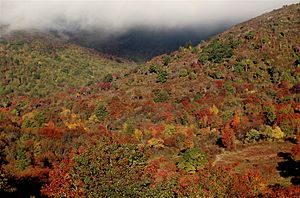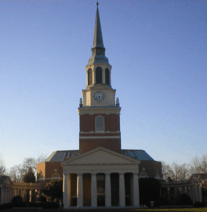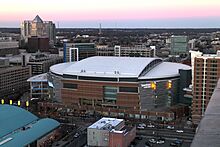North Carolina facts for kids
Quick facts for kids
North Carolina
|
|||
|---|---|---|---|
|
|||
| Nickname(s):
The Tarheel State, The Old North State
|
|||
| Motto(s):
Esse quam videri "To be, rather than to seem"
|
|||
| Anthem: "The Old North State" | |||

Location of North Carolina within the United States
|
|||
| Country | United States | ||
| Before statehood | Province of North Carolina | ||
| Admitted to the Union | November 21, 1789 (12th) | ||
| Capital | Raleigh | ||
| Largest city | Charlotte | ||
| Largest county or equivalent | Wake | ||
| Largest metro and urban areas | Charlotte | ||
| Legislature | General Assembly | ||
| • Upper house | Senate | ||
| • Lower house | House of Representatives | ||
| Judiciary | North Carolina Supreme Court | ||
| U.S. senators | Thom Tillis (R) Ted Budd (R) |
||
| U.S. House delegation |
|
||
| Area | |||
| • Total | 53,819.16 sq mi (139,391.0 km2) | ||
| • Land | 48,617.91 sq mi (125,919.8 km2) | ||
| • Water | 5,201.25 sq mi (13,471.2 km2) 9.66% | ||
| Area rank | 28th | ||
| Dimensions | |||
| • Length | 500 mi (804 km) | ||
| • Width | 184 mi (296 km) | ||
| Elevation | 700 ft (210 m) | ||
| Highest elevation | 6,684 ft (2,037 m) | ||
| Lowest elevation
(Atlantic Ocean)
|
0 ft (0 m) | ||
| Population
(2024)
|
|||
| • Total | |||
| • Rank | 9th | ||
| • Density | 214.72/sq mi (82.90/km2) | ||
| • Density rank | 14th | ||
| • Median household income | $70,800 (2023) | ||
| • Income rank | 39th | ||
| Demonym(s) | North Carolinian (official); Tarheel (colloquial) |
||
| Language | |||
| • Official language | English | ||
| • Spoken language | As of 2010
|
||
| Time zone | UTC−05:00 (Eastern) | ||
| • Summer (DST) | UTC−04:00 (EDT) | ||
| USPS abbreviation |
NC
|
||
| ISO 3166 code | US-NC | ||
| Traditional abbreviation | N.C. | ||
| Latitude | 33° 50′ N to 36° 35′ N | ||
| Longitude | 75° 28′ W to 84° 19′ W | ||
| Song | "The Old North State" |
|---|---|
| Dance | Carolina shag |
| Bird | Cardinal |
| Fish | Red drum |
| Flower | Flowering dogwood |
| Tree | Pine |
| Insect | Western honey bee |
North Carolina ( KARR-ə-LY-nə) is a state in the Southeast of the United States. It shares borders with Virginia to the north and South Carolina to the south. To the east is the Atlantic Ocean, to the southwest is Georgia, and to the west is Tennessee. North Carolina is the 28th largest state and the 9th most populated. It is part of the Carolinas region on the East Coast.
In 2020, about 10.4 million people lived in North Carolina. Raleigh is the state's capital city. Charlotte is the largest city. The Charlotte metropolitan area is the biggest city area in North Carolina. It is also a major banking center, second only to New York City. The Research Triangle area is another large city region. It has the biggest research park in the United States.
People have lived in North Carolina for at least 10,000 years. Native American tribes like the Carolina Algonquian, Iroquoian, and Siouan groups lived here before Europeans arrived. In 1670, King Charles II gave land for a colony named Carolina. It was later split into North and South Carolina in 1729. North Carolina became one of the Thirteen Colonies. On April 12, 1776, North Carolina was the first colony to formally ask for independence from Great Britain. This happened during the American Revolution.
North Carolina became the 12th state to join the United States on November 21, 1789. Before the American Civil War, North Carolina joined the Confederate States of America on May 20, 1861. After the war, it rejoined the Union on July 4, 1868. On December 17, 1903, the Wright brothers made the world's first successful flight. This happened at Kitty Hawk in North Carolina's Outer Banks. Because of this, North Carolina's license plates often say "First in Flight." Some newer plates say "First in Freedom," remembering the state's early push for independence.
North Carolina has many different types of land. From west to east, the land goes down from the Appalachian Mountains to the Piedmont and then to the Atlantic coastal plain. Mount Mitchell is the highest point in North America east of the Mississippi River. Most of the state has a warm, wet climate. The western mountains have a cooler, subtropical mountain climate.
Contents
History of North Carolina
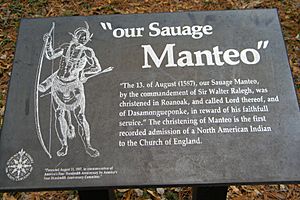
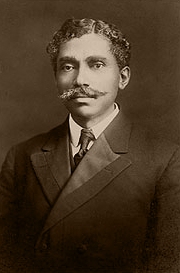
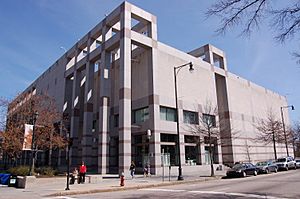
People of the Woodland culture lived in this area around 1000 BCE. Around 750 CE, Mississippian-culture groups formed larger communities. They had stronger leaders and more stable settlements.
By 1550, many Native American groups lived in what is now North Carolina. These included the Chowanoke, Roanoke, Pamlico, and Catawba.
A Spanish explorer named Juan Pardo explored the area in 1566-1567. He built Fort San Juan in 1567.
In June 1718, the famous pirate Blackbeard ran his ship, the Queen Anne's Revenge, aground. This happened near Beaufort Inlet in Carteret County. Blackbeard was killed in an ambush by troops from Virginia in November of that year.
North Carolina became one of the English Thirteen Colonies. It was first part of the Province of Carolina with South Carolina. The northern and southern parts officially separated in 1729.
Early settlers were mostly small farmers. They often grew just enough food for themselves. The colony did not have many large cities or towns.
Pirates were a threat to coastal towns. But by 1718, most of them had been caught or killed.
The colony grew quickly in the mid-1700s. Many immigrants came, including Scots-Irish, Quakers, English, and Germans. Most colonists supported the American Revolution. There were fewer Loyalists (people loyal to Britain) than in some other colonies.
During colonial times, Edenton was the state capital starting in 1722. Then New Bern became the capital in 1766. In 1788, Raleigh was chosen as the new capital. Its central location helped protect it from attacks from the coast. Raleigh was officially founded in 1792. It was named after Sir Walter Raleigh, who supported the "lost colony" of Roanoke.
North Carolina contributed fewer soldiers to the Continental Army than other states. About 7,800 men joined the army. Another 10,000 served in local militia groups.
After 1800, cotton and tobacco became important crops to sell. The eastern part of the state, especially the Tidewater area, used enslaved labor on large farms. After Nat Turner's slave rebellion in 1831, North Carolina limited the rights of free Black people. In 1835, they lost their right to vote.
On May 20, 1861, North Carolina was the last state to leave the Union. It joined the Confederate States of America.
After the Confederacy lost in 1865, the Reconstruction Era began. Slavery was ended.
In 1896, laws were passed to create Jim Crow and racial segregation. This meant public places were separated by race. Black Americans were also prevented from voting. This meant they could not serve on juries or hold local office. Black citizens did not have a political voice until the federal Civil Rights Act of 1964 and Voting Rights Act of 1965 were passed.
The Wright brothers made the first successful powered flight near Kitty Hawk on December 17, 1903.
In the early 1900s, many African Americans moved North for better opportunities. This was called the Great Migration.
North Carolina was greatly affected by the Great Depression. But new government programs helped farmers. After World War II, the state's economy grew fast. Cities like Charlotte, Raleigh, and Durham grew a lot. The Research Triangle became a major area for universities and scientific research.
In the 1990s, Charlotte became a big banking center. Tourism also grew, with people visiting the Outer Banks and the Appalachian Mountains. The Greensboro sit-ins were important in the Civil Rights Movement. They helped bring equal rights to Black Americans.
Geography and Climate
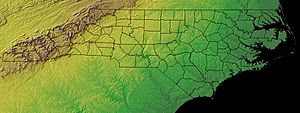
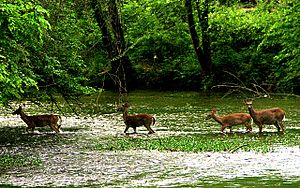
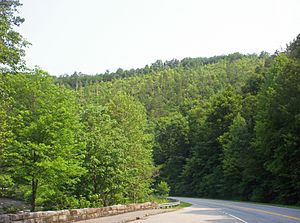
North Carolina is bordered by South Carolina to the south and Georgia to the southwest. To the west is Tennessee, to the north is Virginia, and to the east is the Atlantic Ocean.
The state has three main land regions:
- The Atlantic coastal plain in the east.
- The central Piedmont region.
- The Mountain region in the west, which is part of the Appalachian Mountains.
The coastal plain includes the Outer Banks. These are sandy islands separated from the mainland by sounds. The area near Cape Hatteras is called the "Graveyard of the Atlantic." Over 1,000 ships have sunk there. One famous wreck is the Queen Anne's Revenge, Blackbeard's ship.
The Piedmont region is in central North Carolina. It has gently rolling hills and low mountain ridges. It is the most populated region in the state. The Piedmont ranges from about 300 feet (91 m) in the east to 1,500 feet (457 m) in the west.
The western part of the state is in the Appalachian Mountains. This includes the Great Smoky Mountains and Blue Ridge Mountains. The Black Mountains are the highest in the eastern United States. Mount Mitchell is the highest point at 6,684 feet (2,037 m).
North Carolina has 17 major river basins. Five of these flow to the Gulf of Mexico. The rest flow to the Atlantic Ocean. Four river basins are completely within North Carolina: the Cape Fear River, the Neuse River, the White Oak River, and the Tar River-Pamlico basin.
North Carolina's Climate


The state's elevation affects its temperature. The mountains are cooler all year. The Atlantic Ocean and Gulf Stream also influence the climate, especially near the coast. This makes winters warmer along the coast.
The coastal plain usually gets about 1 inch (2.5 cm) of snow or ice each year. Some years, there is no snow or ice at all.
The Piedmont region has hotter summers and colder winters than the coast. However, daily high temperatures are usually below 90°F (32°C).
North Carolina can have severe weather. In summer, there are hurricanes, tropical storms, heavy rain, and floods. Strong hurricanes like Fran, Floyd, and Hazel have hit the state. Hurricane Hazel in 1954 was the strongest storm to hit North Carolina. Hurricane Isabel was the most damaging in the 21st century.
The state averages fewer than 20 tornadoes per year. Many of these come from hurricanes or tropical storms. Tornadoes from thunderstorms are also a risk, especially in eastern North Carolina. The mountains often protect the western Piedmont from storms.
In April 2011, North Carolina had its worst tornado outbreak. Thirty tornadoes touched down, mostly in the eastern Piedmont. At least 24 people died.
Demographics of North Carolina
| Historical population | |||
|---|---|---|---|
| Census | Pop. | %± | |
| 1790 | 393,751 | — | |
| 1800 | 478,103 | 21.4% | |
| 1810 | 556,526 | 16.4% | |
| 1820 | 638,829 | 14.8% | |
| 1830 | 737,987 | 15.5% | |
| 1840 | 753,419 | 2.1% | |
| 1850 | 869,039 | 15.3% | |
| 1860 | 992,622 | 14.2% | |
| 1870 | 1,071,361 | 7.9% | |
| 1880 | 1,399,750 | 30.7% | |
| 1890 | 1,617,949 | 15.6% | |
| 1900 | 1,893,810 | 17.1% | |
| 1910 | 2,206,287 | 16.5% | |
| 1920 | 2,559,123 | 16.0% | |
| 1930 | 3,170,276 | 23.9% | |
| 1940 | 3,571,623 | 12.7% | |
| 1950 | 4,061,929 | 13.7% | |
| 1960 | 4,556,155 | 12.2% | |
| 1970 | 5,082,059 | 11.5% | |
| 1980 | 5,881,766 | 15.7% | |
| 1990 | 6,628,637 | 12.7% | |
| 2000 | 8,049,313 | 21.4% | |
| 2010 | 9,535,483 | 18.5% | |
| 2020 | 10,439,388 | 9.5% | |
| 2023 (est.) | 10,835,491 | 13.6% | |
| Source: 1910–2020 | |||
In 2020, the population of North Carolina was 10,439,388. In 2012, about 58.5% of people living in North Carolina were born there. About 7.4% were born in other countries.
The main countries of origin for immigrants in North Carolina are Mexico, India, Honduras, China, and El Salvador.
People and Backgrounds
| Race and Ethnicity | Alone | Total | ||
|---|---|---|---|---|
| White (non-Hispanic) | 60.5% |
|
63.9% |
|
| African American (non-Hispanic) | 20.2% |
|
21.8% |
|
| Hispanic or Latino | — | 10.7% |
|
|
| Asian | 3.3% |
|
4.0% |
|
| Native American | 1.0% |
|
2.5% |
|
| Pacific Islander | 0.1% |
|
0.2% |
|
| Other | 0.4% |
|
1.1% |
|
| Racial composition | 1990 | 2000 | 2010 |
|---|---|---|---|
| White | 75.6% | 72.1% | 68.5% |
| Black | 22.0% | 21.6% | 21.4% |
| Asian | 0.8% | 1.4% | 2.2% |
| Native | 1.2% | 1.2% | 1.3% |
| Native Hawaiian and other Pacific Islander |
– | 0.1% | 0.1% |
| Other race | 0.5% | 2.3% | 4.3% |
| Two or more races | – | 1.3% | 2.3% |
In 2010, the people of North Carolina were 68.5% White, 21.5% Black or African American, and 8.4% Hispanic or Latino. In 2020, the numbers changed slightly. Non-Hispanic White people were 62.2%, Black or African Americans were 20.5%, and Asians were 3.3%.
Languages Spoken in North Carolina
| Language | Percentage of population (as of 2010) |
|---|---|
| Spanish | 6.93% |
| French | 0.32% |
| German | 0.27% |
| Chinese (including Mandarin) | 0.27% |
| Vietnamese | 0.24% |
| Arabic | 0.17% |
| Korean | 0.16% |
| Tagalog | 0.13% |
| Hindi | 0.12% |
| Gujarati, Russian, and Hmong (tied) | 0.11% |
| Italian and Japanese (tied) | 0.08% |
| Cherokee | 0.01% |
North Carolina has different ways of speaking English. These include Southern American English and Appalachian English.
In 2010, about 89.66% of people aged five and older spoke English at home. Spanish was spoken by 6.93% of the population. Other languages spoken included French, German, and Chinese. In total, about 10.34% of people spoke a language other than English at home. In 2019, Spanish was the most common non-English language.
Religion in North Carolina
| Religion in North Carolina (2014) | ||||
|---|---|---|---|---|
| Religion | Percent | |||
| Evangelical Protestant | 35% | |||
| Unaffiliated | 20% | |||
| Mainline Protestant | 19% | |||
| Historically Black Protestant | 12% | |||
| Catholic | 9% | |||
| Mormon | 1% | |||
| Eastern Orthodox | 1% | |||
| Jehovah's Witness | 1% | |||
| Jewish | 1% | |||
| Other faith | 1% | |||
Since colonial times, most North Carolina residents have been Protestant. In 2010, the Southern Baptist Convention was the largest Christian group. The United Methodist Church was the second largest. The Roman Catholic Church was the third largest.
In 1845, Baptists split into Northern and Southern groups over slavery. After slavery ended, Black Baptists formed their own churches. Methodists also divided by race.
The state has a special history with the Moravian Church. These settlers came from Germany and settled near Winston-Salem. Presbyterians have a strong presence in Charlotte and Scotland County.
Many other faiths are practiced in North Carolina. These include Judaism, Islam, Baháʼí, Buddhism, and Hinduism. More people from other parts of the U.S. and other countries are moving to North Carolina. This is making the state more diverse in its religions. There are also many Quakers in Guilford County.
Many colleges and universities in the state were founded by religious groups. Some still have those ties today.
- Barton College (Disciples of Christ)
- Belmont Abbey College (Catholic)
- Bennett College for Women (United Methodist Church)
- Brevard College (United Methodist Church)
- Campbell University (Baptist)
- Catawba College (United Church of Christ)
- Chowan University (Baptist)
- Davidson College (Presbyterian)
- Duke University (Historically Methodist)
- Elon University (United Church of Christ)
- Gardner–Webb University (Cooperative Baptist Fellowship)
- Greensboro College (Methodist)
- Guilford College (Religious Society of Friends/Quakers)
- High Point University (United Methodist Church)
- Lees-McRae College (Presbyterian)
- Lenoir-Rhyne University (Evangelical Lutheran Church in America)
- Livingstone College (African Methodist Episcopal Zion Church)
- Louisburg College (United Methodist Church)
- Mars Hill University (Christian)
- Methodist University (United Methodist Church)
- Montreat College (Christian)
- University of Mount Olive (Baptist)
- North Carolina Wesleyan College (United Methodist Church)
- William Peace University (Presbyterian)
- Pfeiffer University (Methodist)
- Queens University of Charlotte (Presbyterian)
- St. Andrews Presbyterian College (Presbyterian)
- Saint Augustine's College (Episcopal)
- Salem College (Moravian Church)
- Shaw University (Baptist)
- Wake Forest University (Historically Baptist)
- Warren Wilson College (Historically Presbyterian)
- Wingate University (Historically Baptist)
North Carolina's Economy

In 2018, North Carolina's total economic output was $496 billion. In 2010-2014, the average household income was $46,693. North Carolina has a very diverse economy. This is because it has a lot of hydroelectric power, a nice climate, and many types of soil. The state is a leader in industry and farming in the South Atlantic region. North Carolina grows the most tobacco in the nation.
Charlotte is the state's largest city. It is a major center for textiles and trade. In 2020, Raleigh was ranked the third-best city for technology. This is due to the state's growing tech industry.
North Carolina is the top U.S. state for growing tobacco and sweet potatoes. It is second in raising pigs, trout, and turkeys. It also ranks second in growing Christmas trees.
North Carolina has 15 metropolitan areas. In 2010, Forbes Magazine called it the third-best state for business. Since 2000, there has been a big difference in economic growth. Urban areas have grown well with more jobs. But many rural areas have lost jobs and people.
Food and Farming
Pork barbecue is a popular food in North Carolina. There are different styles of barbecue. Western North Carolina barbecue uses a tomato-based sauce and only pork shoulder. This style is often called Lexington barbecue. The Lexington Barbecue Festival attracts over 100,000 visitors each October. Eastern North Carolina barbecue uses a vinegar-and-red-pepper sauce. It cooks the "whole hog," mixing white and dark meat.
Many famous food companies started in North Carolina. Krispy Kreme doughnuts started in Winston-Salem. Pepsi-Cola was first made in New Bern in 1898. Cheerwine, a regional soft drink, is still based in Salisbury. The hot sauce Texas Pete was also created in Winston-Salem. Hardee's fast-food chain started in Rocky Mount. Bojangles' fast-food chain began in Charlotte. Golden Corral was founded in Fayetteville. The Mount Olive Pickle Company started in Mount Olive in 1926. Cook Out, a popular fast-food chain, was founded in Greensboro in 1989.
North Carolina has large areas for raising beef and dairy cattle. Many small farms grow fruits and vegetables to sell locally. Shipping, commercial fishing, and lumber are also important industries. Service industries like education, healthcare, and research are growing. Research Triangle Park is a large center for electronics and medical research.
Tobacco was one of the first big industries after the American Civil War. Many farmers grew tobacco. The invention of cigarettes made it very popular. R. J. Reynolds Tobacco Company (RJR) started in Winston-Salem in 1874. Today, it is the second-largest tobacco company in the U.S.
Arts and Culture in North Carolina
North Carolina has rich traditions in art, music, and food. The arts and culture industry brings in $1.2 billion for the state. It supports over 43,600 jobs. The North Carolina Museum of Art was the first major museum in the U.S. created with state money.
Seagrove is a famous arts community. It is known as the handmade-pottery capital of the U.S. Artisans there make pottery using traditions from over two hundred years ago.
Music in North Carolina
North Carolina has many famous jazz musicians. These include John Coltrane, Thelonious Monk, and Nina Simone.
The state is also known for its old-time music. Musicians like Doc Watson came from North Carolina. Both North and South Carolina are famous for traditional blues music, especially the Piedmont blues style.
The band Ben Folds Five started in Winston-Salem. Ben Folds still lives in Chapel Hill. The British band Pink Floyd was partly named after Chapel Hill bluesman Floyd Council.
The Research Triangle area is a known center for folk, rock, metal, jazz, and punk music. James Taylor grew up near Chapel Hill. His song "Carolina in My Mind" is like an unofficial state song. Other famous musicians from North Carolina include J. Cole, DaBaby, Shirley Caesar, and Eric Church.
North Carolina has had more American Idol finalists than any other state. It also has the most American Idol winners. These include Fantasia Barrino, Scotty McCreery, and Caleb Johnson.
The Brevard Music Center in the mountains hosts many music performances in the summer. North Carolina has five professional opera companies. There are also three major symphony orchestras. The Carolina Ballet is based in Raleigh.
The state has three large performing arts centers. These centers host concerts, operas, and Broadway shows.
Shopping in North Carolina
North Carolina offers many shopping options. SouthPark Mall in Charlotte is the largest and most fancy mall in the Carolinas. Other major malls in Charlotte include Northlake Mall.
Other big malls in the state include Hanes Mall in Winston-Salem. There's also Crabtree Valley Mall in Raleigh. Friendly Center in Greensboro and Concord Mills in Concord are also popular.
Transportation in North Carolina

North Carolina has systems for air, water, road, and rail travel. This includes Amtrak trains and light rail in Charlotte. North Carolina has the second-largest state highway system in the country. It also has the largest ferry system on the East Coast.
North Carolina's airports have flights to places across the U.S. and to other countries. Charlotte Douglas International Airport is the 11th busiest airport in the U.S. Raleigh-Durham International Airport is the 37th busiest.
North Carolina has a growing passenger train system. Amtrak serves most major cities. Charlotte has the state's only light rail system, called LYNX.
Major Highways
Primary Interstate Highways
 I-26
I-26 I-40
I-40
 Future I-42
Future I-42 I-73
I-73 I-74
I-74 I-77
I-77 I-85
I-85 I-87
I-87 I-95
I-95
Auxiliary Interstate Highways
 I-140
I-140 I-240
I-240


 Future I-274
Future I-274 I-277
I-277 I-285
I-285 I-295
I-295 I-440
I-440 I-485
I-485 I-495
I-495 I-540
I-540 I-587
I-587


 Future I-685
Future I-685 I-785
I-785 I-795
I-795 I-840
I-840 I-885
I-885
Education in North Carolina
Schools and Learning

Public schools for elementary and high school students are managed by the North Carolina Department of Public Instruction. The North Carolina Superintendent of Public Instruction leads the state's school system. North Carolina has 115 public school systems. Each system has a local school board.
The largest school systems are Wake County Public School System and Charlotte-Mecklenburg Schools. In total, there are 2,425 public schools in the state. This includes over 200 charter schools. Schools in North Carolina were separated by race until the Brown v. Board of Education court case.
Students used to take the SAT test to get into college. In 2012, a new law required 11th graders to take the ACT. This made the ACT the main college entrance exam.
Colleges and Universities
In 1795, North Carolina opened the first public university in the U.S. This is now the University of North Carolina at Chapel Hill. Today, the University of North Carolina System has 16 public universities.
- Appalachian State University
- East Carolina University
- Elizabeth City State University
- Fayetteville State University
- North Carolina A&T State University
- North Carolina Central University
- North Carolina State University
- University of North Carolina at Asheville
- University of North Carolina at Chapel Hill
- University of North Carolina at Charlotte
- University of North Carolina at Greensboro
- University of North Carolina at Pembroke
- University of North Carolina School of the Arts
- University of North Carolina at Wilmington
- Western Carolina University
- Winston-Salem State University
The system also includes one public high school, the North Carolina School of Science and Mathematics. North Carolina also has 58 public community colleges. The largest university is North Carolina State University, with over 34,000 students.
North Carolina also has many well-known private colleges and universities. These include Duke University, Elon University, and Wake Forest University. Shaw University was the first historically Black college or university in the South.
The John C. Campbell Folk School is the oldest and largest folk school in the U.S.
Sports in North Carolina
-
Bank of America Stadium in Charlotte, home of the Carolina Panthers and Charlotte FC
-
Carolina Hurricanes Stanley Cup awards ceremony at the RBC Center in Raleigh
-
The Spectrum Center, home arena of the NBA's Charlotte Hornets
North Carolina has four major professional sports teams. The Carolina Panthers (football) and Charlotte Hornets (basketball) are in Charlotte. Charlotte FC (soccer) is also in Charlotte. The Carolina Hurricanes (hockey) are based in Raleigh. The Hurricanes won the Stanley Cup in 2006.
North Carolina does not have a Major League Baseball team. But it has many Minor League Baseball teams. The highest level teams are the Charlotte Knights and Durham Bulls. The state also has minor league teams for soccer and ice hockey.
North Carolina is strongly linked to NASCAR and stock-car racing. Charlotte Motor Speedway hosts two major NASCAR races each year. Charlotte also has the NASCAR Hall of Fame. Many top racing teams are based in Concord, North Carolina.
Golf is a popular activity. North Carolina has hosted important golf tournaments. Pinehurst Resort has hosted the U.S. Open twice. The Wells Fargo Championship is a regular stop on the PGA Tour.
College sports are very popular in North Carolina. Eighteen schools compete at the Division I level. The Atlantic Coast Conference (ACC) is based in Greensboro. College basketball is especially popular. The Tobacco Road rivalries between North Carolina, Duke, NC State, and Wake Forest are famous.
Images for kids
-
The New York State Capitol in Albany
See also
 In Spanish: Carolina del Norte para niños
In Spanish: Carolina del Norte para niños






